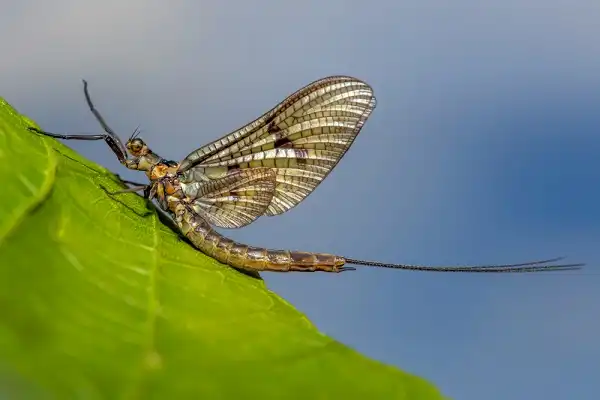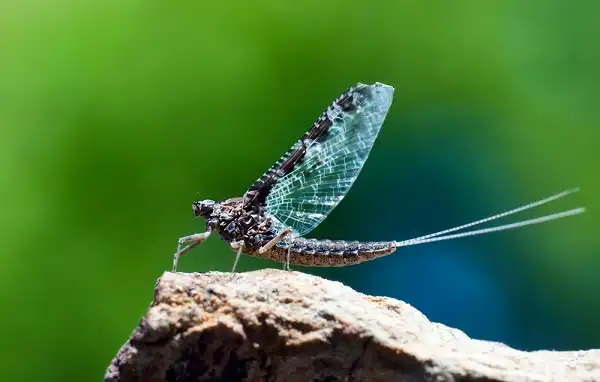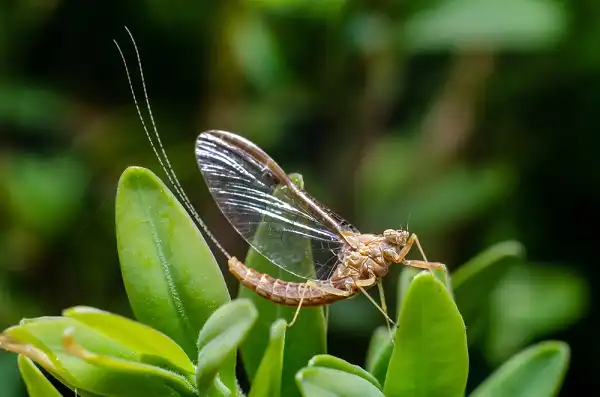Have you ever stopped to think about how the life cycle of a mayfly can be related to your own? Perhaps it’s an unusual comparison at first, but upon closer inspection, you’ll realize that there are parallels between the way mayflies live and our lives as human beings. In this blog post, we will explore the fascinating relationship between these delicate aquatic insects and ourselves. Mayflies start out their lives by burying themselves in lakes or streams where they transform from larvae into adults through metamorphosis in only a few days – much like us humans who have our own process of physical growth over time. Let’s take a deeper dive into how these insect creatures play a role in teaching us crucial lessons about life!

Mayfly Description
Mayflies have two pairs of wings that are used for flying. They also have three sets of legs and two very long antennae used for sensing their environment. Their bodies generally range in color from green, yellow, and brown to black, depending on the type of species. Their short lifespan has become an important lesson in the grand scheme of things – it serves as a reminder to us humans that we should make the most out of our limited time here on earth. We may not be able to fly like these delicate insects, but we can take a page from their book and apply the same concept to our own lives. The mayfly’s life cycle also teaches us something else – how valuable change is! In order for mayflies to survive and thrive, they must go through their four stages of transformation. This process helps them reach maturity and eventually be able to reproduce so that their species can continue on in nature.
Mayfly Habitat
Mayflies usually inhabit freshwater environments such as streams, lakes, ponds, and wetlands. They can be found all over the world in tropical and temperate areas. Mayflies prefer clean bodies of water with lots of vegetation for food and shelter. They are also sensitive to pollution so their presence is a good indicator of the health of an ecosystem. The lesson here is that we should strive to live in harmony with nature rather than take it for granted. We have a responsibility to protect our environment and ensure that it remains healthy for future generations. By understanding the importance of mayfly habitats, we can work towards preserving them so that these delicate aquatic insects can continue to thrive in our ecosystems.
Mayfly Diet
Mayflies have a simple diet that is closely tied to their larval stage. As aquatic larvae, they feed on detritus and organic matter found on the bottom of freshwater bodies. This diet enables them to thrive in nutrient-rich environments, and they play an important role in the food chain as a food source for fish and other aquatic predators. Once they reach the adult stage, mayflies lose their ability to feed as they do not possess functional mouthparts. This means they must rely on their stored energy reserves. As a result, adult mayflies do not contribute to the food chain in the same way as their larval counterparts. Despite their limited impact on the food chain as adults, mayflies have a significant ecological significance as indicators of water quality. The sensitivity of these insects to pollutants and changes in water quality makes them an important tool for monitoring aquatic ecosystems.
Mayfly Size
Mayflies come in a wide range of sizes, with some species barely visible to the naked eye, while others can reach up to 3 inches in length. The smallest mayflies, such as the Caenis species, have a body length of only 2-3mm, while the largest species, such as the Hexagenia limbata, can grow up to 30mm in length, including their wings. Mayfly size is affected by a variety of factors, including species, habitat, and environmental conditions. Despite their wide range in size, all mayflies share certain characteristics. These insects have slender bodies and two pairs of wings that are typically held upright like a sail when at rest. Mayflies also have large compound eyes that give them excellent vision, as well as long, delicate legs that are used for perching on surfaces such as leaves, rocks, and water. The size of mayflies is not only important for their physical characteristics but also plays a crucial role in their overall ecology. For example, larger mayflies tend to be a more significant food source for fish, which are important predators in many freshwater ecosystems. Additionally, the size of mayflies can impact their ability to fly, mate, and lay their eggs successfully.

Mayfly Lifespan
Mayflies are known for their brief but fascinating existence. Although their lifespan is typically only a matter of hours to a few days, they play a significant role in the ecology of freshwater ecosystems. The exact lifespan of mayflies varies depending on the species and environmental factors, such as water temperature, food availability, and habitat quality. Mayflies undergo a unique developmental process called incomplete metamorphosis. They go through three life stages: eggs, nymphs, and adults. During the nymph stage, which can last for up to 2 years, mayflies live underwater, feeding on algae and other organic matter. As they mature, they move to the surface of the water and shed their exoskeletons to emerge as adults.
Mayfly Behavior
Mayflies have a rich and fascinating behavior that has drawn the attention of naturalists and enthusiasts alike. Although their short lifespan limits the time available for observation, researchers have uncovered remarkable aspects of mayfly behavior that shed light on their ecological and evolutionary significance. One of the most notable behaviors of mayflies is their synchronized emergence, which occurs in large numbers and often draws the attention of predators, such as birds, bats, and fish. This emergence, also known as a hatch, is triggered by a combination of environmental factors, such as temperature, light, and water flow, which synchronize the development of the nymphs and their emergence as adults. The timing and intensity of mayfly hatches can vary widely between species, locations, and seasons, and can have significant ecological effects on both aquatic and terrestrial ecosystems. Once mayflies emerge as adults, they undergo a period of intense mating activity that can involve complex behaviors, such as courtship displays, territorial conflicts, and aerial acrobatics. Male mayflies, which typically outnumber females, form swarms over the water, where they compete to attract females with their flashing wings and flight patterns. Once they find a mate, the pair engages in brief and dramatic copulation, which can take place in mid-air or on the surface of the water. After mating, females lay their eggs on the surface of the water, either singly or in clusters, which sink to the bottom and develop into nymphs.
Mayfly Speed
Mayflies are known for their remarkable synchronized emergence and intense mating activity, but their speed is also an interesting aspect of their behavior. Despite their delicate appearance, mayflies are remarkable flyers, with some species capable of reaching speeds of up to 35 miles per hour. One key factor that contributes to the speed of mayflies is their lightweight and streamlined body shape. Mayflies have large wings relative to their body size, which helps them generate lift and reduces drag during flight. They are also expert gliders, able to catch thermals and winds to gain altitude and travel long distances without expending much energy. Another factor that contributes to the speed of mayflies is their ability to navigate accurately and react quickly to environmental stimuli.
Mayflies have highly developed visual and sensory systems, which allow them to detect and respond to changes in light, temperature, and water quality. For example, polarized light vision enables mayflies to orient themselves based on the polarization pattern of sunlight, while their sensitivity to water quality can alert them to potential threats or opportunities in their environment. Mayflies are also known for their agility and aerial acrobatics, which help them evade predators and compete for mates. Male mayflies in particular exhibit impressive flight maneuvers, ranging from rapid wing beats to synchronized displays of flashing wings and body movements. These behaviors not only attract females but also serve as a form of defense against predators, such as bats and birds.

Mayfly Hunting
Mayfly hunting is a common activity for many predatory animals, including birds, bats, and fish. The delicate and easily accessible bodies of mayflies make them an ideal prey item, and their synchronized emergence and mating activity provide a tempting target for predators looking to capitalize on a plentiful food source. However, mayflies are not defenseless. Their agility, aerial acrobatics, and synchronization can make them a challenging prey item for even the most skilled hunters. Male mayflies, in particular, exhibit impressive flying displays and rapid wing beats that help them evade predators and compete for mates. They also have a keen sense of environmental stimuli, allowing them to detect and react quickly to changes in light, temperature, and water quality, which can alert them to potential threats in their surrounding environment.
Mayfly Importance in Ecosystem
Mayflies are a keystone species in freshwater ecosystems, providing essential food sources for both aquatic and terrestrial predators as well as valuable indicators of water quality and environmental health. Their remarkable navigational abilities, sensitivity to environmental stimuli, and synchronized emergence and mating activities make them fascinating creatures with adaptations that allow them to survive in a range of aquatic habitats. As such, they play an important role in maintaining the balance of their ecosystems, from nutrient cycling to energy transfer from primary producers (e.g., plants) to consumers (e.g., fish). By understanding the significance of mayfly presence or absence in any given ecosystem, conservationists can better assess the health of freshwater systems and develop specific strategies for restoring degraded habitats.
Mayfly Types
Mayflies belong to the order Ephemeroptera, which includes over 2,500 species worldwide. They are typically divided into four major groups based on their behavior and morphology: borrowers, clingers, crawlers, and swimmers. Each type of mayfly has its own distinct characteristics that enable it to thrive in different habitats and climate conditions. For example, burrowing mayflies live in sandy or gravelly bottoms where they dig tunnels for protection from predators; clinging mayflies prefer fast-moving streams where they can attach themselves to rocks or other surfaces; crawlers can be found near shorelines or under rocks in shallow waters; and swimmers inhabit deeper lakes and rivers where they use their long tails to help them maneuver swiftly through the water. Regardless of their type, all mayflies possess 2 or 3 short filaments that are used for respiration and a pair of long tails they use to maneuver through the water while swimming. These adaptations, coupled with their dependence on clean freshwater habitats, make them extremely vulnerable to human-induced disturbances such as pollution and habitat destruction.

Conclusion
Mayflies are an important part of freshwater ecosystems, serving as valuable indicators of water quality and providing a tempting food source for predators. Their remarkable aerial acrobatics, navigational abilities, and sensitivity to environmental stimuli make them fascinating creatures with adaptations that allow them to survive in a range of aquatic habitats. However, mayflies face significant threats from human activities such as pollution and habitat destruction. To protect these remarkable creatures and their vital role in freshwater ecosystems, it is essential to continue studying their behavior and ecology while implementing conservation initiatives aimed at preserving their habitats and reducing human impacts on freshwater ecosystems. By doing so, we can ensure the future existence of these beautiful insects and help maintain the health of our aquatic environments.
Frequently Asked Question


